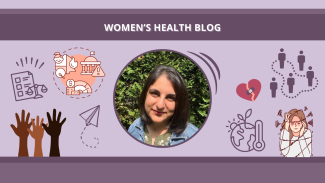Interviewee: Dr. Shahin Kassam, RN, PhD, Postdoctoral Research Fellow, University of British Columbia School of Nursing, Capacity Research Unit
Authors/Editors: Romina Garcia de leon, Shayda Swann (Blog Co-coordinators)
Published: February 9th, 2024
This week we talk to Shahin Kassam who tells us about her work on forced migration, specifically how displacement (for reasons such as climate instability, political conflict, coercion and human trafficking) impacts local and international intersections where gender, race, class and migrant status converge to shape women’s health and access to health and social services.
Can you tell us a bit more about your research?
My doctoral research looked at how public health nurses located here in British Columbia support women living with refugee status while also transitioning into parenthood. This intersectionality-framed research identified fragmented pathways women have to self-navigate to access health and social systems while also living with the impacts of gender-based violence, discrimination, and fear stemming from migration policies.
This doctoral work opened up more questions for me to further understand women’s experiences of accessing systems of health and social well-being and how they are shaped by these conjoint experiences of racial discrimination, gender-based violence, and their migrant status. To specify “forced migration” in this work is important because when we talk about migration it is often in binaries, either voluntary or involuntary. Experiences of being forced can be about being categorized by policy as a refugee, or as seeking asylum. But it can also be categorizations where women are rendered dependent and socially disconnected thereby increasing their risk for gender-based violence exposure and consequential chronic and acute health problems such as post-traumatic stress disorder, depression, hypertension, diabetes, and asthma. Rather than systems deciding whether a woman migrates forcibly or not, why are we not letting women’s experiences shape the narrative?
Essentially the research I'm doing just really intentionally ensures that we place women and their experiences at the forefront of understanding forced migration.
What drew you to this work?
I come from a clinical public health nursing background. My research took off from the stories and experiences that I had with varying women with different backgrounds who experienced marginalization or disadvantages such as poverty or lack of support, literacy skills, and limited education. I constantly saw the inequities that these women faced and couldn’t let go of how that deserved more attention. So I think that just really propelled me into doing more.
Can you share any findings from this work?
As a Postdoctoral Research Fellow, I’m working with my supervisor Dr. Vicky Bungay who is the Scientific Director of the Capacity Research Unit and professor at the UBC School of Nursing, to build my program of research involving the development of non-profit community partnerships with sectors that are really integral to the safe settlement of women. So the research being done is informed by community-based participatory research principles where the community drives the research process. The overarching goal is to inform the enhancement of access to health and social services with the experiences of women impacted by gender-based violence, racism, and forced migration.
Through a SSHRC Partnership Engagement Grant, our community co-lead, Diana Ospina from DIVERSEcity Community Resources Society (DCRS) and I convened a group of leaders from three additional non-profit organizations focused on settlement service delivery. Together we met often and shaped the research process. We recruited nine women who had been in Canada from 0-5 years across varying races, migrant statuses, and languages such as Spanish, Ukrainian, Dhari, and Tigrinya.
Some of the key findings that we found through these women’s stories were that women need support in their pursuit of meaningful employment and integration into the labor market sector. Loss of financial independence and dealing with poverty is very challenging. Language barriers continue and language classes are often inaccessible because of the lack of affordable childcare. Another finding is housing that is safe from forms of violence or exploitation. The need for social growth and connections is another finding. When women arrive in Canada, often their only connection is their partner or their partner's family/friends, creating dependency.
To further understand the experiences of women impacted by forced migration, we are hoping to grow through further funding opportunities to delve deeper into this work.
Given the lack of attention to forced migration, and women’s health, what keeps you moving forward?
A big part of doing this work is grit and tenacity and simply not giving up. I think that if you are passionate about something, and you're surrounded by support, that I think those are two big key ingredients to doing the work. For me, it's the applied experiences as a nurse that continue to just really propel me in this direction. And then I think it's the pragmatic and inclusive pillars and the values that align my work with the Capacity Research Unit and the School of Nursing that have promoted building and weaving together this program of research.
How can people learn more about your work?
Website: Shahin Kassam’s website
Research Unit: Capacity Research Unit, Women’s Stories of Forced Migration
More information:
Funder: SSHRC Partnership Engagement Grant
Principle Investigator: Dr. Vicky Bungay, UBC School of Nursing, Capacity Research Unit
Community Co-Applicant: Ms. Diana Ospina, DIVERSEcity Community Resources Society
Academic Co-Applicant: Dr. Shahin Kassam, Postdoctoral Research Fellow
Community Collaborators:
